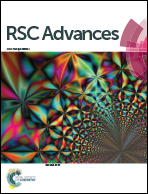Room temperature two-photon-pumped random lasers in FAPbBr3/polyethylene oxide (PEO) composite perovskite thin film†
Abstract
Solution-processed organic–inorganic halide lead perovskites have attracted increasing attention due to their great potential in low-cost, effective, and versatile light emission applications and large-scale portable optoelectronic devices. In this paper, formamidinium lead tribromide perovskite thin films composited with polyethylene oxide (PEO) were fabricated by a solution processing method. Great enhancement of photoluminescence was observed and more attractively, two-photon-pumped random lasing action could be achieved at room temperature when pumped by a nanosecond pulse laser with excitation wavelength centered at 1064 nm. Evident transition from spontaneous upconversion emission to random lasing action was investigated by monitoring the log–log light emission slope and peak width at half height. The lasing threshold is at around 1.1 mJ cm−2, which is comparable to that of other two-photon upconversion random lasers. The efficient random lasing emission originates from the multiple random scattering provided by the micrometer-scale rugged morphology and polycrystalline grain boundaries. Compared with conventional lasers that normally serve as a coherent light source, the perovskite random lasers show promise in fabricating low-cost thin-film lasing devices for flexible and speckle-free imaging applications.



 Please wait while we load your content...
Please wait while we load your content...